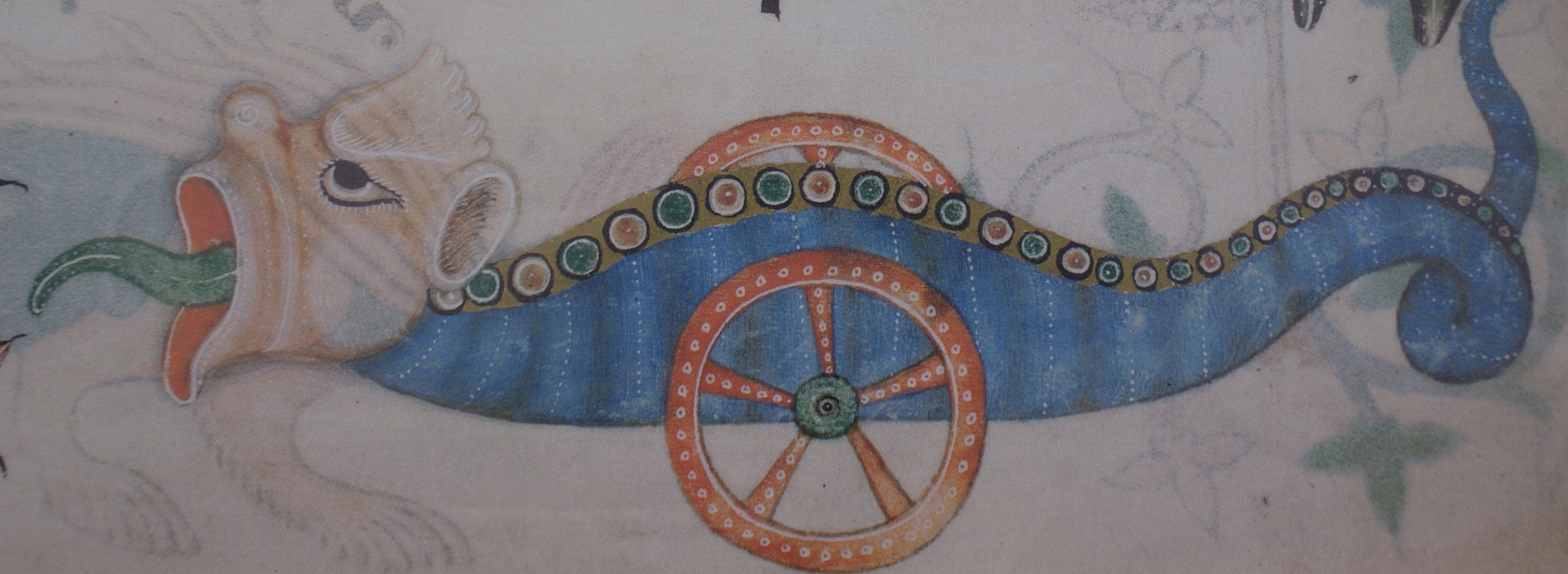Faith and Community: Processions and Plays
Rogation Days
The Monday to Wednesday in May just before Ascension Day were three days of prayer for the health of a community, celebrated by processions in many places, but each having its own local features. In Beverley (East Riding of Yorkshire), the shrine of St John of Beverley was carried in procession from the Minster (where his grave is still marked) through the town. In Ripon (West Riding), more surprisingly, a dragon (‘draconem’ in the Latin record) seems to have been a feature of the procession:
Et in salario vnius hominis portantis draconem per tres dies rogacionum cum processione & in festo Ascensionis domini xvj. d. videlicet in quolibet die iiij. d.</p
And for the salary of a man carrying the dragon for three Rogation days and on Ascension Day, 16 d., viz. 4 d. per day.
This fine wheeled specimen from the fourteenth century Luttrell Psalter shows how dragons were imagined, and perhaps built for processions, in our period; we have no picture of the actual Ripon dragon, but it may have looked not unlike this.

Corpus Christi Day
Corpus Christi Day falls nine weeks after Easter and was marked throughout Europe by processions celebrating Christ’s redeeming sacrifice of his body. In Durham, civic dignitaries processed with the shrine of Corpus Christi from St Nicholas’ Church up to the north door of the Cathedral, to be met by Cathedral clergy.
One of the treasures of Durham Cathedral is a fifteenth century cope (a clerical vestment), which was worn by a senior cleric in the procession. Its beautiful embroideries, called orphreys, show scenes from the story of Jesus, from his betrayal to the Last Judgement, which may have been the subjects of the Durham play.
Boy Bishop Ceremonies
Boy Bishop ceremonies featured in Durham, York, Beverley and other places with important churches or cathedrals. On feast days appropriate to children – such as the feast of St Nicholas (who became our familiar modern Santa Claus) or the Feast of the Holy Innocents, the children killed by King Herod – churches would appoint a Boy Bishop from among their choristers, to dress in rich robes like those of a real bishop, go in procession through ‘his’ parish, lead the congregation in prayer and preach a sermon. Durham in fact had two, unusually appointed in the summer; one chosen by the Cathedral, the other – the ‘bishop of Elvet’ – in St Oswald’s parish.
From York we have a record of a goldsmith being paid by the Minster authorities for repairing and re-gilding the Boy Bishop’s robes. From Selby Abbey in the West Riding there are records of visits from the Boy Bishop of York – quite an expedition, which probably accounts for the large payment of 6s. 8d. – the equivalent now of 33p, but worth very much more at that time!
York Pageants
York is the only place in this region where we have not only very full records but also a complete text of the play: it is a manuscript now in the British Library, and the complete play contains forty-eight playlets known as pageants – as were the wagon stages on which they were performed in York, Beverley and Newcastle.

This parchment manuscript of 1433, a precious survival, still belongs to the York Company of Merchant Adventurers and details the set, props and costumes for their Last Judgment (‘Doomsday’) pageant which formed the spectacular finale to the York cycle performance.
Although the writing is now faded, scholars have been able to decipher it. It is a uniquely helpful text, enabling directors and actors to understand more about how the York ‘Doomsday’ pageant really looked and to experiment with effective ways of staging and performing the text.
York Merchants’ (Mercers’) pageant document (MA: D63) Transcript
11 June 1433
This endenture made in þe feste of Corpus christi In þe ȝere of oure lorde god ml. CCCC xxxiij betwene Richard louth Maister of þe Cumpany of Mersers of þe Cite of Ȝorke & Nicholas Vseflete & William Ȝarom Cunstables of þe saide Cumpany on þe to syde And William Bedale William Holbek Henry Market & Thomas Curtays þan Pagent Maisters on þe tother syde beris Witnes þat þe saide Maister & constables has deliuerde to þe saide Pagent Maisters all þir parcelles vnderwretyn langing to þaire pagent safely to kepe & to gouerne for þaire tyme And thos same parcelles to deliuer forthe agayne in resonable tyme to þe nexte Pagent Maisters þat sall occupy in þe nexste ȝere after And so all Pagent Maisters to deliuer forth be þis endenture to other Pagent Maisters þat sall occupy for þe ȝere While þe Pagent gere lastes ffirst a Pagent with iiij Wheles helle mouthe iij garmentes for iij deuels vj deuelles faces in iij Vesernes Array for ij euell saules þat is to say ij Sirkes ij paire hoses ij vesenes & ij Chauelers Array for ij gode saules þat is to say ij Sirkes ij paire hoses ij vesernes & ij Cheuelers ij paire Aungell Wynges with Iren in þe endes ij trumpes of White plate & ij redes iiij Aubes for iiij Appostels iij diademes with iij vesernes for iij Appostels iiij diademes with iiij Cheuelers of ȝalow for iiij Apostels A cloud & ij peces of Rainbow of tymber Array for god þat ys to say a Sirke Wounded a diademe With a veserne gilted A grete coster of rede damaske payntid for the bakke syde of þe pagent ij other lesse costers for ij sydes of þe pagent iij other costers of lewent brede for þe sydes of þe Pagent A litle coster iiij squared to hang at þe bakke of god iiij Irens to bere vppe heuen iiij finale coterelles & a Iren pynne a brandreth of Iren þat god sall sitte vppon when he sall sty vppe to heuen With iiij rapes at iiij corners A heuen of Iren With a naffe of tre ij peces of rede cloudes & sternes of gold langing to heuen ij opeces of blue cloudes payntid on bothe sydes iij peces of rede c;oudes With sunne bemes of golde & sternes for þe hiest of heuen With a lang small border of þe same Wurke vij grete Aungels halding þe passion of god Ane of þame has a fane of laton & a crosse of Iren in his hede giltid iiij smaller Aungels gilted holding þe passion ix smaler Aungels payntid rede to renne aboute in þe heuen A lang small corde to gerre þe Aungels renne aboute ij shorte rolls of tre to putte forthe þe pagent
York Merchants’ (Mercers’) pageant document (MA: D63) Modernised Version
This indenture made on the feast of Corpus Christi in the year of our Lord God 1433 between Richard Louth, Master of the Company of Mercers of the City of York and Nicholas Useflete & William Yarom, Constables of the said Company, on the one side, and William Bedale, William Holbek, Henry Market & Thomas Curtays, then Pageant Masters, on the other side, bears witness that the said Master and Constables have delivered to the said Pageant Masters all their items underwritten belonging to their pageant, safely to keep and to govern for their time, and those same items to deliver up again in reasonable time to the next Pageant Masters who shall occupy (i.e. be in post) in the next year after. And so all Pageant Masters to deliver up by this indenture to (the) other Pageant Masters who shall occupy for the year, while the pageant gear (i.e. equipment) lasts.
First a pageant (wagon) with 4 wheels; Hell mouth; 3 garments for 3 devils; 6 devils’ faces in 3 masks; array for 2 evil souls, that is to say 2 shirts, 2 pairs of hose, 2 masks and 2 wigs; array for 2 good souls, that is to say 2 shirts, 2 pairs of hose, 2 masks & 2 wigs; 2 pairs angel wings with iron in the ends; 2 trumpets of white plate (i.e. silver-plated) and 2 reeds; 4 albs for 4 apostles; 3 crowns with 3 masks for 3 apostles; 4 crowns with 4 yellow wigs for 4 apostles; A cloud & 2 pieces of rainbow (made) of timber; array for God, that is to say a shirt, wounded, a crown with a gilded mask; a large hanging of red damask, painted, for the back of the pageant (wagon); 2 other smaller hangings for two sides of the pageant (wagon); 3 other hangings of linen broadcloth for the sides of the pageant (wagon); a little hanging, four-squared, to hang behind God; 4 irons (i.e. poles?) to hold up Heaven; 4 end-bolts & an iron pin; a trivet of iron that God shall sit on when he shall ascend to heaven, with 4 ropes at (the) 4 corners; a Heaven of iron with a nave (i.e. a centre piece?) of timber; 2 pieces of red clouds & gold stars belonging to Heaven; 2 pieces of blue clouds painted on both sides; 3 pieces of red clouds with sunbeams of gold and stars, for the highest (level) of Heaven, with a long narrow border of the same work; 7 large angels holding the (instruments of the) passion of God – one of them has a brass banner and a gilded cross made of iron on its head; 4 smaller angels, gilded, holding the passion (instruments); 9 smaller angels, painted red, to run round in the Heaven; a long narrow cord to make the angels run round; 2 short rolls of timber to move the pageant (wagon).


